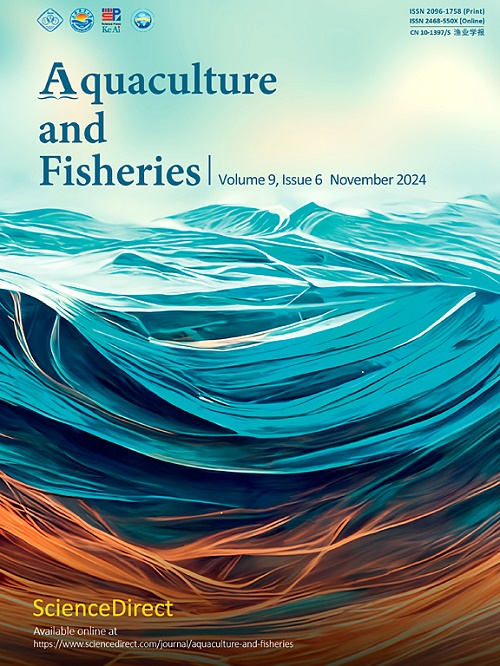Characterization of gill transcriptome, SSR/SNP markers and expression analysis of lysozyme LysC gene from Carassius auratus upon Aeromonas hydrophila infection
Q1 Agricultural and Biological Sciences
引用次数: 0
Abstract
The gills are large mucosal surfaces and play primary roles in respiration and immune defences. However, the molecular mechanism for gills of fish needs still to be explored. In the present study, transcriptomic analysis and identification of SSR and SNP markers were performed in the gills of crucian carp Carassius auratus. The results showed a total of 84,259 unigenes were annotated to NCBI NR, KEGG and GO databases for 55,283, 39,303, 33,388, respectively. Enriched KEGG pathway analyses for the identified genes showed the mainly functional modules such as metabolism, cellular processes, environmental adaptation, genetic processing, organismal and immune systems. Moreover, 22,102 SSRs (simple sequence repeats) were potentially identified and 9776 (44.2%) were accounted for the most dinucleotides. Transition and transversion sites of SNPs (single nucleotide polymorphisms) were also observed. Tissue distribution showed that the expression level of lysozyme LysC gene was relatively high in intestine, liver, spleen and kidney tissues and up-regulated in gills, skin and brain after the A. hydrophila infection. We discovered the immune-related pathways through the transcriptome analysis in the gills of crucian carp, some potential SSR/SNP markers were identified, and lysozyme gene predominantly expressed in mucosal immune organs (eg., gills, skin, intestine) responded to A. hydrophila infection. To the best of our knowledge, this was the detailed report on the molecular characteristics in crucian carp gills with transcriptome analysis, which will not only provide a scientific reference for further understanding the local defense mechanism, but also lay a foundation for molecular marker-assisted breeding in fish.
嗜水气单胞菌感染鲫鱼鳃转录组、SSR/SNP标记及溶菌酶LysC基因表达分析
鳃是大的粘膜表面,在呼吸和免疫防御中起主要作用。然而,鱼鳃的分子机制仍有待进一步研究。本研究对鲫鱼鳃进行了转录组学分析及SSR和SNP标记的鉴定。结果显示,共有84259个unigenes被注释到NCBI NR、KEGG和GO数据库中,分别为55,283、39,303和33,388个。富集的KEGG通路分析显示,所鉴定基因的主要功能模块包括代谢、细胞过程、环境适应、遗传加工、机体和免疫系统。此外,潜在鉴定的简单序列重复序列为22102个,其中二核苷酸最多的为9776个(44.2%)。单核苷酸多态性(snp)的过渡位点和翻转位点也被观察到。组织分布表明,溶菌酶LysC基因在嗜水单胞菌感染后,在肠、肝、脾和肾组织中表达量较高,在鳃、皮肤和脑组织中表达量上调。我们通过对鲫鱼鳃的转录组分析,发现了与免疫相关的途径,鉴定出了一些潜在的SSR/SNP标记,溶菌酶基因主要表达于粘膜免疫器官(如;(鳃、皮肤、肠道)对嗜水单胞杆菌感染有反应。据我们所知,这是利用转录组分析对鲫鱼鳃的分子特征进行的详细报道,这不仅将为进一步了解鲫鱼鳃的局部防御机制提供科学参考,也将为鱼类分子标记辅助育种奠定基础。
本文章由计算机程序翻译,如有差异,请以英文原文为准。
求助全文
约1分钟内获得全文
求助全文
来源期刊

Aquaculture and Fisheries
Agricultural and Biological Sciences-Aquatic Science
CiteScore
7.50
自引率
0.00%
发文量
54
审稿时长
48 days
期刊介绍:
 求助内容:
求助内容: 应助结果提醒方式:
应助结果提醒方式:


